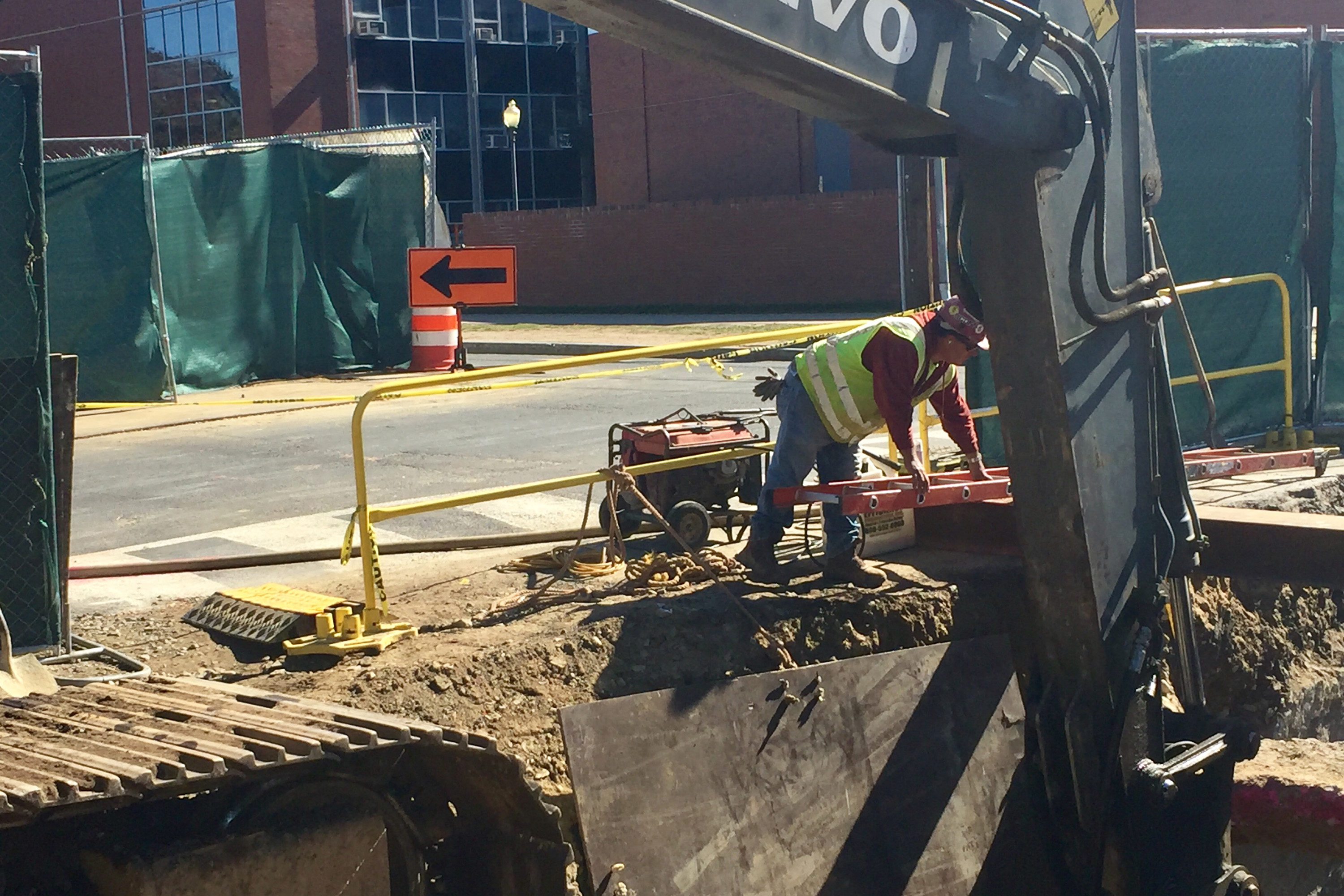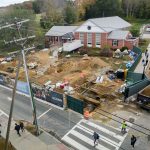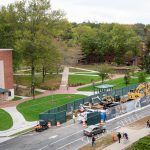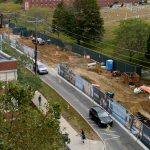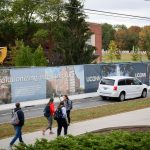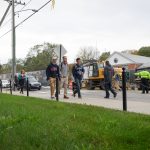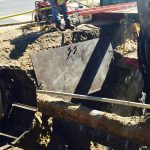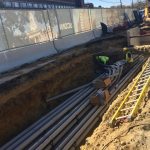UConn has had to extend the schedule on a major project to replace pipes and other infrastructure under North Eagleville Road due to unforeseen complications, including the need to break up and haul away massive amounts of underground rock.
The majority of the project, which started in May, had been slated to wrap up by the end of the calendar year, with landscaping elements completed in spring 2018. However, construction will now be placed on hiatus at the end of this calendar year, and resume in summer 2018.
Work crews have repeatedly encountered stubborn bedrock deep under the ground during the excavation, requiring extensive work with jackhammers and other heavy equipment to break it up, then more work to load it and haul it away from the sites.
Workers have also found many instances where the old underground utilities were not in the locations shown on old drawings of the areas. That meant once the crews located the pipes, in some instances they had to be rerouted, and in other cases, the plans for adjacent new utility lines had to be redesigned – all of which added delays to the original schedule.
UConn has about 47,000 linear feet of underground steam and condensate lines dating from the 1930s through the 1960s, the last major update across the Storrs campus.
It also has dozens of miles of underground water lines throughout campus, with many of those pipes well past the age when they should have been replaced. The same holds true for other underground utilities, such as electrical and telecommunications circuits, and storm water drainage and sewage collection systems.
And because they’re underground, the University can rarely predict leaks or other problems, leaving crews scrambling to replace and repair portions – often in poor weather conditions – as buildings close due to lack of the necessary water to operate fire-suppression systems.
Officials did expect to encounter bedrock under North Eagleville Road during the project to replace the aging infrastructure, but not to anywhere near the extent that proved to be hidden below ground.
Workers used ground-penetrating radar and other investigation methods before starting construction to try to pinpoint the existing pipes, but were unable to identify all potential problems in advance.
In addition to finding pipes out of place and massive slabs of bedrock, construction crews also have found remnants of old pipes and other debris that was covered over during previous repairs or the original installation in the 1930s.
Even though contractors have worked 24-hour shifts for six days per week for most of the construction so far, those extended schedules were not sufficient to overcome the unforeseen conditions encountered on the project.
Although the work will not be done by the end of December as originally anticipated, the University has decided to temporarily put it on hold during the coming spring semester, both to avoid more inconvenience to the campus community and because winter work is difficult and risky.
The road will be open to two-way traffic from Discovery Drive through Route 195 for the spring semester. Then the construction work will resume after Commencement and continue into summer 2018, when the on-campus population drops significantly.
“We recognize and share the frustration of those in the community who hoped this work would be completed soon, but it’s not unusual to run into unforeseen circumstances in a project of this magnitude and with such a short window of time to complete a significant amount of work,” says Brian Gore, UConn’s director of project and program management. “We are doing all that’s within our power to minimize the inconvenience, and we appreciate everyone’s patience.”
For now, work crews are finishing all they can before the end of the calendar year, including extensive excavation needed to reach and replace the various underground pipes that transport water and steam to buildings along the road.
New curbs, sidewalks, and other finishes will be built along the road in front of the Storrs Cemetery and the various houses of worship over the coming months, before the project goes on hiatus at the end of the year.
For now, North Eagleville is open only to construction and local traffic eastbound, with no through traffic allowed.
When approaching campus from Route 195 north, drivers are asked to enter campus at Discovery Drive via Route 44; and from Route 195 south, entering on Bolton or Mansfield roads is the easiest option.
The University recently opened a short piece of the westbound lanes of North Eagleville Road from the Route 195 campus entrance to a point near the Islamic Center, part of a plan to create a temporary new traffic pattern.
Now, drivers who enter campus at westbound North Eagleville Road are guided to a U-turn around a traffic island, heading them back east towards Glenbrook Road and Route 195. The change allowed the University to remove the orange construction cones from Route 195 nearby.
Redirecting traffic has been a major task in the project, which involves replacing water and sewer lines, pipes that carry steam to heat buildings, and electrical duct banks. Significant portions of the work on the western portion of the road were completed last summer and in summer 2016.
In addition to replacing aged utilities, the project also upgrades these utilities to ensure that the future planned campus development shown in the University’s Campus Master Plan is also accommodated. It is funded with money from the Next Generation Connecticut initiative, a campus improvement program approved by the state General Assembly and Gov. Dannel P. Malloy.
